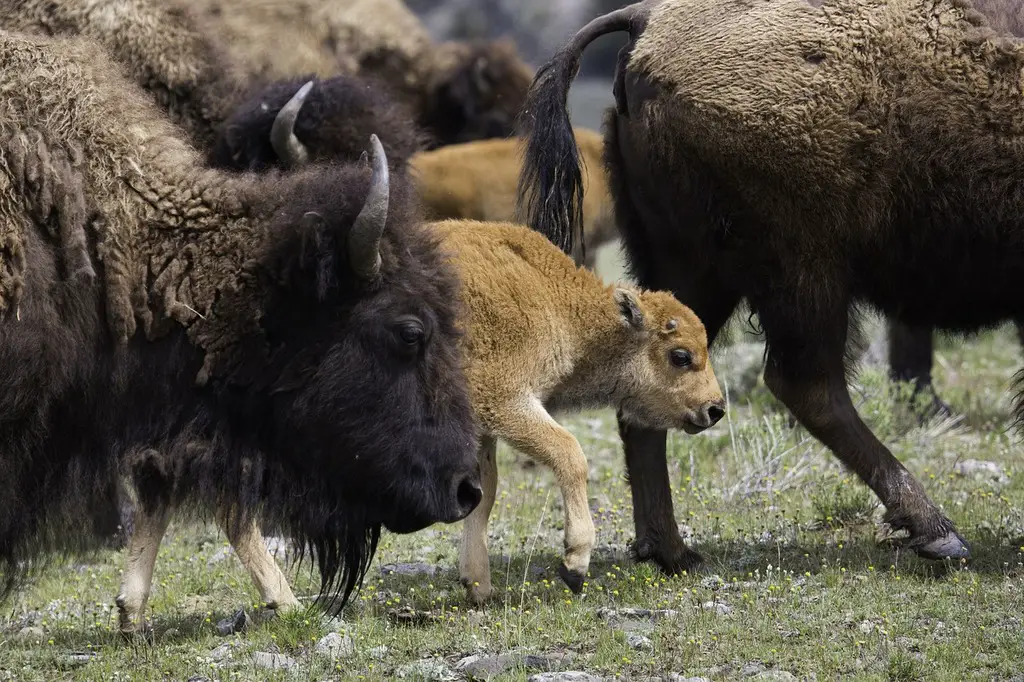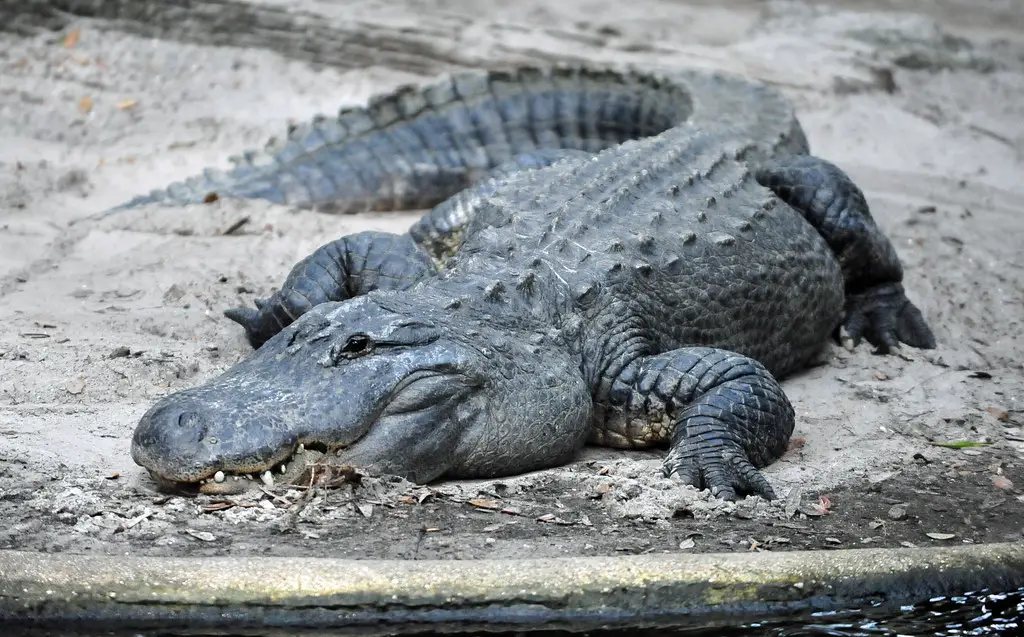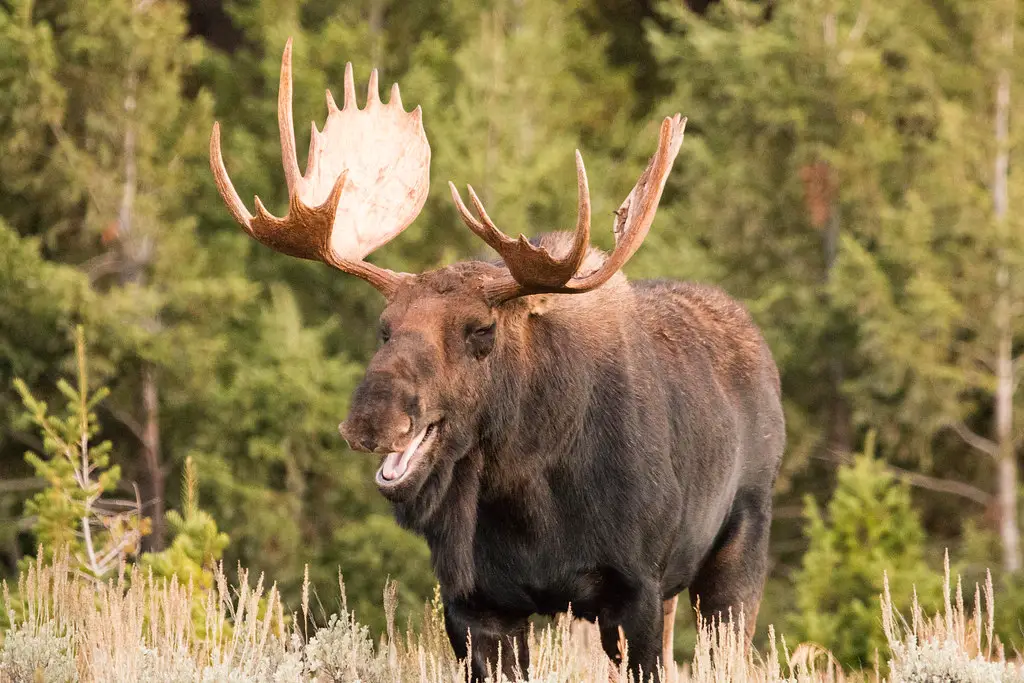We all know the internet loves a good “cute animal” list—fluffy squirrels, wide-eyed owls, and those chubby-cheeked chipmunks we pretend aren’t just rats with PR. But here’s the twist: some of the most adorable creatures in America are secretly stone-cold killers. Like, “oh look at this sweet woodland fuzzball” followed immediately by “call 911, I’ve been gored.”
From snuggly beasts that weigh more than your car to sneaky critters with venomous bites, this list is here to ruin your idea of “cuteness = harmless.” So next time you spot a wide-eyed animal staring at you from the trees, just remember: nature’s deadliest weapons often come wrapped in fur, fluff, and a false sense of security. Let’s dive into 13 American animals that are cuter than a viral TikTok… and more dangerous than you’d ever expect.
1. American Bison

They may look like gentle giants grazing peacefully in the meadows, but American bison are anything but tame. Weighing up to 2,000 pounds and capable of running at speeds up to 40 mph, these beasts can be incredibly aggressive, especially during mating season or when protecting their young. Despite their bulky appearance, bison are surprisingly agile and can jump over fences and obstacles with ease. In Yellowstone National Park, bison have injured more people than any other animal, including bears, according to CNN.
Tourists often underestimate the danger, approaching too closely for selfies or to feed them, leading to serious injuries. Park officials continuously warn visitors to maintain a safe distance of at least 25 yards from bison. Their unpredictable nature and immense strength make them one of the most dangerous animals in North America, despite their docile appearance.
2. American Black Bear

With their round ears and curious eyes, American black bears might seem like oversized teddy bears. However, they are powerful predators capable of inflicting serious harm. Black bears are the most common bear species in North America and are known for their intelligence and adaptability. While they typically avoid humans, encounters can turn dangerous if the bear feels threatened or is habituated to human food.
In recent years, there have been several reports of black bear attacks, some resulting in fatalities. For instance, per the New York Post in May 2025, an elderly man in Florida was fatally mauled by a black bear—the state’s first recorded fatal bear attack. Such incidents highlight the importance of respecting wildlife and maintaining a safe distance, no matter how cute they may appear.
3. Raccoon

Those masked faces and dexterous little hands make raccoons look like mischievous bandits, and their antics often amuse urban dwellers. However, raccoons can be aggressive when cornered and are known carriers of diseases such as rabies and leptospirosis, according to Discover Wildlife. Their adaptability has led them to thrive in urban environments, increasing the likelihood of human encounters.
Raccoons are notorious for rummaging through trash cans and entering homes in search of food. When threatened, they can bite or scratch, potentially transmitting diseases. It’s essential to secure garbage and avoid feeding or approaching these seemingly charming creatures to prevent unwanted and dangerous interactions.
4. American Alligator

With their toothy grins and prehistoric appearance, American alligators are fascinating yet formidable reptiles. Found primarily in the southeastern United States, they inhabit freshwater environments like swamps, rivers, and lakes. While alligator attacks on humans are relatively rare, they can be deadly when they occur.
Alligators are ambush predators, capable of sudden bursts of speed both in water and on land, reports The New York Times. They can remain submerged with only their eyes and nostrils above water, making them nearly invisible to unsuspecting prey. Human encroachment into their habitats increases the risk of encounters. It’s crucial to heed local warnings and avoid swimming or wading in areas known to be inhabited by alligators.
5. Feral Hog

At first glance, feral hogs might resemble domestic pigs, but these wild swine are aggressive and destructive. With populations estimated between 6 to 9 million in the U.S., they cause significant agricultural and environmental damage, costing an estimated $2.5 billion annually.
Feral hogs are known to attack humans, especially when wounded or cornered, according to News Press. They have sharp tusks and can run at speeds up to 30 mph. Their aggressive nature and rapid reproduction make them a challenging invasive species to control. Efforts to manage their populations include hunting and trapping, but their numbers continue to rise, posing risks to both humans and native wildlife.
6. Eastern Diamondback Rattlesnake

The Eastern Diamondback Rattlesnake, with its distinctive diamond pattern and ominous rattle, is both beautiful and deadly. As the largest venomous snake in North America, it can grow up to 8 feet long. Its venom is potent, capable of causing severe tissue damage and, if untreated, death.
Despite their fearsome reputation, these snakes are not aggressive and typically avoid human contact. However, they will defend themselves if threatened. Encounters often occur when people inadvertently step too close. Wearing boots and being vigilant in snake-prone areas can help prevent dangerous encounters with these deceptively striking reptiles. They’re especially active in warmer months, so hikers and campers should be on high alert. A rattling tail is your warning shot—ignore it, and you’re rolling the dice. Thankfully, antivenom is widely available, but the pain and recovery are still no picnic. Basically: admire from afar, or risk a venomous regret.
7. Moose

With their long legs and gentle eyes, moose might seem like the gentle giants of the forest. However, they are responsible for more attacks on humans than bears in some regions. Moose can become aggressive, especially during mating season or when protecting their calves.
Weighing up to 1,500 pounds and capable of running at speeds up to 35 mph, a charging moose is a formidable threat. They have been known to charge vehicles and people, causing injuries and fatalities. It’s essential to keep a safe distance and avoid provoking these massive animals, no matter how docile they may appear. Moose don’t have the patience for your Instagram story—if they feel boxed in, they’ll come at you like a freight train with antlers. Their size means they can easily flip a car or stomp a person flat. People often misread their calm demeanor for friendliness. Pro tip: it’s not a smile—it’s just their face.
8. Cougar

Also known as mountain lions or pumas, cougars are elusive and solitary predators. Their sleek appearance and graceful movements can be mesmerizing, but they are powerful hunters capable of taking down large prey. While attacks on humans are rare, they have occurred, particularly in areas where human development encroaches on cougar habitats.
Cougars are most active during dawn and dusk. If you encounter one, it’s crucial to appear larger, make noise, and avoid turning your back or running, as this could trigger their predatory instincts. Understanding and respecting their space is vital to coexisting safely with these majestic yet dangerous felines. Think of them as giant, silent cats with an attitude problem and nothing to lose. If a cougar’s staring you down, it’s not admiring your outfit—it’s weighing you like a steak. Their powerful jaws and stealthy approach make them master ambush predators. Cute from a distance; lethal if you make the wrong move.
9. Brown Recluse Spider

Small and unassuming, the brown recluse spider is one of the most venomous spiders in North America. Its bite can cause severe necrotic lesions and, in rare cases, systemic symptoms leading to death. These spiders are reclusive by nature, often hiding in dark, undisturbed areas like closets, attics, and shoes.
Despite their dangerous bite, brown recluse spiders are not aggressive and typically bite only when pressed against the skin. Regularly inspecting and shaking out clothing and bedding, especially in areas where these spiders are common, can help prevent unwanted encounters. Their innocuous appearance belies the serious harm they can inflict. The real horror? You usually don’t feel the bite until the damage is done. Days later, you could be dealing with an ulcerated wound that looks like a zombie movie prop. And yes, they love dark corners, like that shoebox you haven’t touched since 2017. Keep your home clutter-free—or risk a surprise eight-legged guest.
10. Domestic Dog

Man’s best friend can sometimes be man’s worst nightmare. While most dogs are friendly and loyal, certain breeds or improperly trained individuals can pose serious risks. Dog attacks account for a significant number of animal-related injuries and fatalities in the U.S. each year.
Children are particularly vulnerable, and attacks can result in severe injuries or death. Responsible ownership, proper training, and socialization are crucial in preventing dog attacks. It’s also important to teach children how to interact safely with dogs and to recognize warning signs of aggression. Even the fluffiest pup can lash out if it’s scared, sick, or provoked. The danger isn’t in the breed—it’s in the hands of the owner. Neglect, poor training, and mistreatment can turn a loyal pet into a lethal liability. So yes, that golden retriever might be adorable, but always ask before you pet.
11. Deer

Graceful and timid, deer are a common sight in many parts of the U.S. However, they are responsible for more human deaths annually than any other animal, primarily due to vehicle collisions. Deer-related accidents cause hundreds of fatalities and thousands of injuries each year.
During mating season, deer are more active and less cautious, increasing the likelihood of road crossings. Drivers should remain vigilant, especially at dawn and dusk, and use high-beam headlights when appropriate to spot deer from a distance. Despite their serene appearance, deer can be deadly on the roads. That startled Bambi look? It means they’re about to bolt—in your direction. Hitting a full-grown buck can total your car and land you in the ER. And good luck trying to swerve—it usually makes things worse. PSA: brake, don’t veer, and always expect the unexpected in deer country.
12. Polar Bear

Yes, they look like giant, snuggly snowballs. But don’t let the Coca-Cola commercials fool you—polar bears are apex predators with zero chill. Native to the Arctic regions of Alaska, these massive bears can weigh over 1,200 pounds and are strong enough to flip ice floes. Despite their isolated habitat, melting sea ice is pushing them closer to human settlements.
Polar bears are intelligent, patient hunters who can track prey for miles. They’ve been known to stalk humans and can sprint surprisingly fast over short distances—think grizzly bear in a white fur coat. They also have the bite force to crush a seal skull like it’s a juice box. Unlike other bears, they don’t hibernate, which means they’re always ready to rumble. So if you ever spot one outside your tundra Airbnb? Close the blinds and don’t engage—unless your life insurance policy is airtight.
